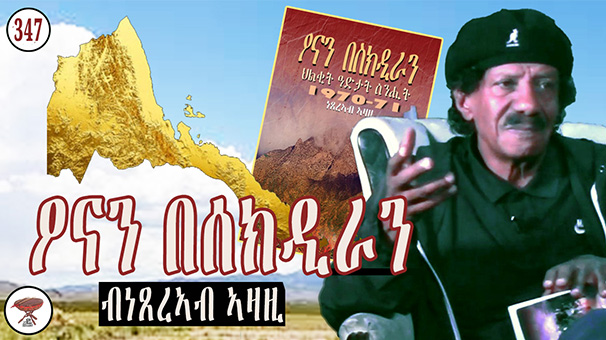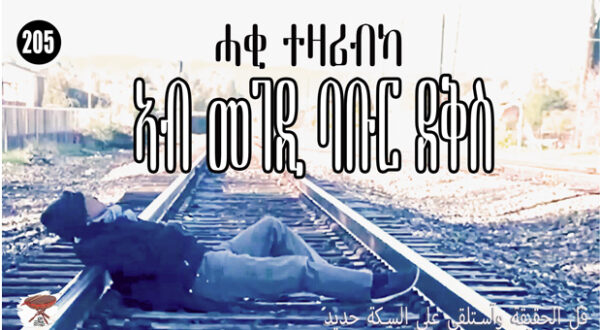Netsereab Azazi’s Book—Ona and Besekdira
I have written and spoken about Ona—a turning point in my life and among my peers. I thought that experience was as intense as life could get. Reliving those events shakes a person to the core; it is a deeply traumatic experience. What I saw remains etched in my memory. When something stirs those recollections, I find myself wanting to cry—and often, I do.
What happened in Ona and Besekdira was a horrendous massacre, especially for a young teenager. I can only imagine how it felt for the victims, yet I can narrate it as a witness—I lived and breathed before, during, and after that tragedy. My story reflects not the inner pain of the victims but the anguish of one who saw it unfold.
When I read Azazi’s book, it brought everything back. I couldn’t go through more than a few pages at a time; the vivid details overwhelmed me. Sometimes I had to step away for a day or two. Reading it as one would read a normal story was impossible—it disturbs the mind, troubles the soul, and forces you to relive the horror.
A Book Imitating Marco Polo
Let me tell you a story within a story—the saga of how the book reached me, a journey that could rival Marco Polo’s travels.
A friend, MS, told me about a newly published book on Ona and Besekdira. I told him I was eager to read it and asked, “Where can I get it?”
He promised to send me the address, but instead, he called back asking for mine: “I’ll order the book for you—it’s a gift.” I thanked him and waited, thinking it would take a week. I was in the middle of moving, so I gave him another address. It never arrived. We later discovered I had given the wrong house number, and the package was returned to the sender.
After resending it to the correct address, the book was delayed, and I was out of town. A friend whose house I used as my mailing address called to say I had mail. He had a guest who asked to read it before I came to pick it up, and I gladly agreed. Two weeks later, when I went to pick it up, the book was gone. The guest’s wife had seen him reading it and assumed it was his, so she packed it when they both flew back to Sweden. He realized the mistake three weeks later and promised to send it—but didn’t.
Then tragedy struck. He had to travel to Africa when a close relative fell critically ill. He planned to post the book en route to the airport, but upon hearing that his relative had passed away, he forgot it in his suitcase. He stayed for over a month, attending to family matters. Only on his way back home did he finally ship it from England.
Nearly four months had passed before I received it. Embarrassed, I didn’t call MS before the book was in my hands. Quite a journey, wasn’t it?
Two weeks ago, I finally began reading it; I strongly recommend the book—it broadens one’s understanding of what truly happened in Ona and Besekdira. You can order the book on Barnes & Noble here: https://shorturl.at/U4XvO.
For my version of an eyewitness narration, watch Negarit 111, TbaH-Tbah, as the Ethiopian General Tecleberhan derogatorily calls the shedeli, the tribal facial marks that resemble 111. It’s meant to help him so he doesn’t miss it. The Negarit episode is linked above.
Perspectives
Narrators offer different perspectives—each distinct, each shaped by circumstance. A direct observer’s view differs from that of a victim, yet both are primary sources. Their emotions, judgments, and proximity influence how the story is told. I once thought my own account, written as a firsthand witness, carried the deepest emotion. But reading Azazi’s book—with its rich interviews, detailed geography, names, and family ties—revealed the tragedy with a vividness that surpassed my own recollection.
Time and distance matter when preserving memory. My goal of documenting Eritrea’s untold stories has been obstructed; I am branded an enemy of the state—a fugitive under an authoritarian regime. How I wish I could walk again through those familiar villages, now unreachable.
Time, as they say, is like a sword—if you don’t cut it, it cuts you. But in the hands of Eritrea’s rulers, time has become a lethal weapon. For decades, they have pursued a campaign of social re-engineering, silencing witnesses and erasing memories. They fear those who can challenge their rewriting of history. That is why I cannot write or speak without condemning the PFDJ—it is both my duty and my curse.
Tragicomedy
Azazi beautifully documents not only the main story but also its periphery. He magnifies small details, giving them meaning and weight. I will conclude with what I consider a powerful anecdote, a brief but haunting story on page 346 of Netserab Azazi’s Ona and Besekdira. It’s a story of a sword that survived its owner, embodying the tragic irony and resilience of that time. The tragicomic life of most Eritreans. A life where normal life visits once every few decades.
Two days before the massacre, Fitwerari Mohammed Ismael told Adey Abet, “We cannot predict what will happen; keep my sword safe together with Grazmatch’s sword.”
Adey Abet joked, “Fitwerari, since when does a woman safeguard a man’s property?”
Handing her the sword, Fitwerari replied, “It’s all right—for today, we’ll count you among the men.”
Tragically, Fitwerari’s sword survived, but he did not. After the Ona massacre, his son Ahmed retrieved his father’s sword from Aboy Ali-Hassen’s house.
Those few lines form a perfect tragicomedy—simple yet profound, capturing both the spirit and sorrow of that era, or the usual life of Eritreans. As for me, it’s a book blending memory, trauma, and resistance through my personal journey and the tragedy of Eritrea’s massacres. That is why I have been fighting against violence and oppression; I hate to see anyone go through the painful experience we had to go through.
You can order the book on Barnes & Noble here:
https://shorturl.at/U4XvO.
Negarit 142: ሕማቕ ዘምህሩኻ – bad lessons – دروس سيئة
youtube.com/watch?v=-S8DtN1qiqQ&feature=youtu.be
Support Awate/Negarit 2025
https://awate.com/support-awate-negar…




Awate Forum